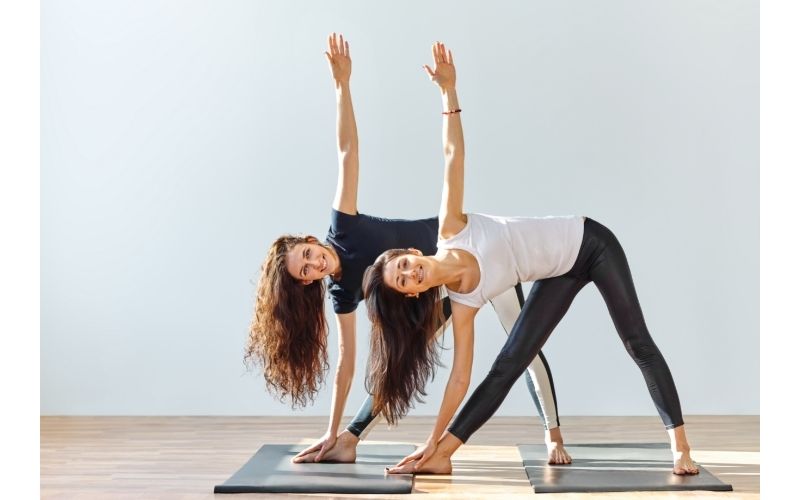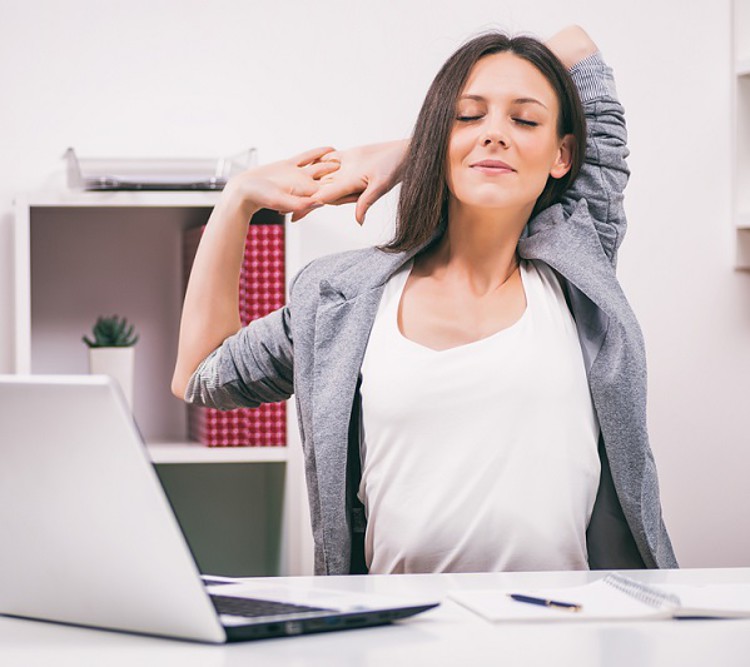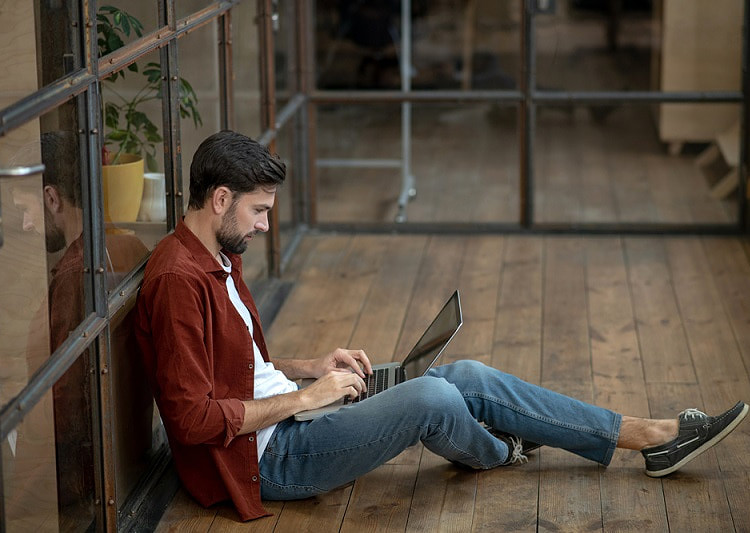Sitting all day at your desk can leave your muscles sore and tight, especially if you don’t get the chance to take breaks and walk around.
That’s why it’s important to stretch your legs from time to time while at work. But how can you stretch while sitting down?
We’ve found that there are several ways to stretch your legs while sitting at your desk, including a hip stretch, a knee hug, a calf stretch, a quad stretch, an inner thigh stretch, an IT band stretch, a hamstring stretch, and a foot stretch. All of these stretches can be done in a small space like a cubicle.
Table of Contents
Can you stretch while sitting?

Yes, you can!
Seated stretches were originally created for people who cannot easily lie down or put a lot of stress on their joints.
However, over the past few years, experts have found that sitting for hours in a row can tighten muscles and compromise circulation, which sometimes leads to blood clotting or deep vein thrombosis (DVT).
To counteract these effects, the body needs to be stretched. So, seated stretches were further developed to help people stretch while working.
How do you stretch your legs while sitting down?
Many parts of your body could lead to your legs feeling tight or painful, so it’s best to do stretches for all of them.
That’s why we’ve compiled the most effective yet straightforward seated leg stretches below, including stretches for your hips, knees, calves, quads, inner thighs, IT bands, hamstrings, and feet.
Hip Stretch
Although technically part of your torso, your hips may contribute to leg pain if they are tight.
To stretch your hips, follow these easy steps:
- Sit with one leg across the other, making a figure 4 with your legs.
- Make sure you’re sitting up with a straight back.
- Pull the knee of your crossed leg towards your opposite shoulder.
- Bring your chest to your knee but keep your back straight. Hold for at least 10 seconds.
- Then pull the knee across your body towards the opposite hip and hold for at least 10 seconds.
- Finally, hold your ankle with the opposite hand and push down your knee with the hand on the same side. Stretch as much as you’re comfortable with.
- Bring your chest to your knee but keep your back straight. Hold for at least 10 seconds.
- Repeat on the other side.
Knee Hug
It may sound strange, but hugging your knees can help relieve tension in your legs!
Follow these steps to do the knee hug stretch:
- Sit up straight on your chair.
- Hug one knee towards your chest and keep the other foot flat on the floor.
- Stretch as much as you’re comfortable with, and always keep your back straight.
- Hold for at least 10 seconds.
- Repeat on the other side.
Calf Stretch
Our calves are often the tightest parts of our legs since they do most of the movement and carry most of the weight.
To stretch your calves and relieve some tension, you can follow these steps:
- Sit up properly.
- Lift one leg, keeping it straight, and make sure your other foot is flat on the floor.
- If you’re comfortable enough, you can also flex your ankle by pointing your toes up and down while keeping your leg straight.
- Hold for at least 10 seconds.
- Repeat on the other side.
Quad Stretch
If you feel a tightness in the front of your thigh, chances are your quads need to be stretched.
To stretch your quads, follow these simple steps:
- Slide as close to the edge of your chair as you can without becoming unstable.
- Lean back in your chair.
- Bend your knees but stay comfortable.
- Engage your core and push down on your armrest with your arms.
- Push down through your heels and squeeze your glutes to stretch your quads and hip flexors.
- Look down slightly, and make sure your back stays straight.
- Hold for 3-5 seconds.
Inner Thigh Stretch
Although we may not feel like we use our inner thighs much, they can still get tight from sitting all day.
To stretch your inner thighs, you can follow these steps:
- Open your legs wide and point your toes out.
- Lean forward and put your elbows on your thighs.
- Keep your back straight and engage your core.
- Press forward and use your elbows to push your thighs outwards.
- Hold for at least 10 seconds.
IT Band Stretch

The iliotibial band or the IT band is on the outside of your thigh.
If your IT band feels tight, you can stretch it using these steps:
- Straighten one leg in front of you and flex your foot while squeezing your quad (front of thigh).
- Keep your other foot flat on the ground.
- Fold forward and reach with your opposite hand to the straightened leg’s shin.
- If you want, you can then twist your torso up to the ceiling on the side of your straightened leg. This is similar to a triangle pose in yoga.
- Hold for at least 20 seconds.
- Repeat on the other side.
Hamstring Stretch
If you feel a tightness in the back of your thigh, you probably have to stretch your hamstring.
To stretch your hamstring, you can follow these steps:
- Straighten one leg forward and keep your other foot flat on the floor.
- Turn your toes and whole leg outwards.
- Hinge toward your thigh but keep your back straight.
- Hold for at least 10 seconds.
- Sit back up.
- Turn your toes and whole leg inwards.
- Hinge toward your thigh but keep your back straight.
- Hold for at least 10 seconds.
- Repeat on the other side.
Foot Stretch
Your feet can also cause leg pain since your foot muscles are connected to your leg muscles.
To stretch your feet, you can follow these steps:
- Sit up straight with your feet flat on the floor.
- Lift your heels and flex your feet while keeping your toes on the floor.
- Hold this position for at least 3 seconds, then rest your heels.
- Lift your toes and flex your feet while keeping your heels on the floor.
- Hold this position for at least 3 seconds, then rest your toes.
- Go back and forth between these movements for at least 10 repetitions.
How often should you stretch when sitting?
Experts recommend that for every hour you sit, you should take a break for 5-10 minutes.
So, ideally, you should stretch hourly when sitting.
If you can’t, you can lump together your stretching breaks. For example, you can stretch for 15-30 minutes after 3 hours of sitting.
Is it bad to stretch every day?
![]()
Not at all!
If anything, the more you stretch, the better.
As you grow older, your joints become less flexible and can cause you pain – especially if you spend most of your time sitting in a static position.
But if you stretch regularly, you can improve your flexibility even as you get older. Daily stretching is best since it gives your joints the daily stimulation they need.
Conclusion

Stretching your legs while sitting is very possible, with many seated stretches available for your use, including stretches for your hips, knees, calves, quads, inner thighs, IT bands, hamstrings, and feet.
Stretching for 5-10 minutes for every hour you spend sitting down is ideal, but if you can’t do it hourly, you can group stretches and do them for longer periods of time.
The most important part about stretching is doing it as regularly as possible, so if you can, we recommend doing it daily.
We hope that this guide helped you find the right stretch for your legs!

My name is Vance, and I am the owner of To Ergonomics. Our mission is to improve your workflow by helping you create a supportive and welcoming environment. We hope that you’ll find what you’re looking for while you’re here.

